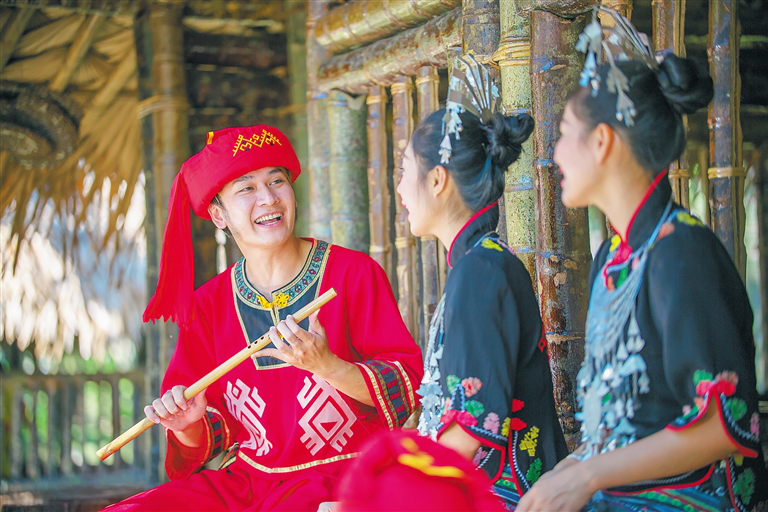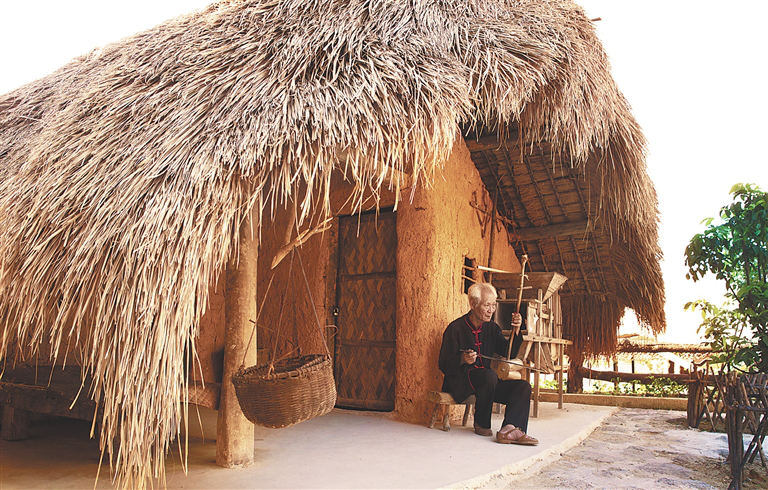2021-09-24 20:14:26
The Li and Miao communities live around the Hainan Tropical Rainforest National Park for generations. These ethnic minorities have their own customs and habits, which are mainly manifested in marriages, funerals, festivals, diet, residence, dress, receiving guests, etiquette, and recreational activities. Many historic sites and relics are the testimony of local history and profound culture. Li brocade, pottery and Miao batik are elaborately crafted; dance performances and folk songs show distinct ethnic style; traditional festivals celebrated by local ethnic groups have unique charm; and boat-shaped houses and thatched roof cottages look so different. The ethnic craftsmanship, customs, architecture and myths highlight the outstanding creative genius of local people and represent the great value of Chinese culture.

(1) Traditional costumes - Li brocade
Li brocade, with a history of more than 3,000 years, is a living fossil in the textile history of China. This form of textile arts was recorded as early as the Spring and Autumn Period (771-401 BC) and the Warring States Period (401-256 BC).
Li brocade fabrics include skirts, kerchiefs, braids, belts, sheets, quilts and so forth, which require textile processes from spinning to weaving, dyeing and embroidery. The products are mostly brown and black, with green, red, white, blue and yellow tinges. Patterns such as flowers, plants, birds, animals and figures are printed to make the clothes look more exotic. Li people’s brocade craft has long been highly prized for its exquisite design, grandiose and romantic colors, artistic and vivid patterns, harmony color matching, and unique ethnic style. Tapestry, dyeing and figured weaving are predominantly found in Li brocade products, while embroidery works are fewer. They are dyed with native plants in bright colors and do not fade easily. Li communities in different regions adopt different techniques of weaving, dyeing and embroidery according to their preferences. For example, the Li people in Baisha County are good at a double-sided embroidery process that is similar to the kind of Suzhou embroidery.
(2) Ethnic customs - Embroidery style tattoo
Tattoos are named differently among the Li and Han Chinese. Tattooing remains a traditional custom of the Li nationality. It is the legacy of the Li matriarchal clan society and shows the religious worship of nature, ancestors and totem, thus known as the “Dunhuang frescoes on the human body” and Li’s “oracle bone inscription”. Tattoos are commonly favored by people around the world since ancient times, and tattoo culture spreads from Asia to Africa and Oceania. For example, tattoos have been a part of human culture for Polynesians on the Pacific islands, Dulong people in Yunnan and Taiya people in Taiwan, China. For females from the Li groups, particularly, tattooing has been a long-standing tradition.
At the age of 12-16, there is a mysterious tattoo ritual in autumn, when tattoos are applied to the face, chest, hands and legs. Then people need to bathe in water boiled with longan leaves to finish the rite. People with no tattoos will be treated as traitors of the community. The total area of tattoos occupies 40% of the skin on the body, which differs in regions with different language and culture.
Why are tattoos so important for local people? Experts and scholars have offered different answers based on field surveys and historical records, indicating that tattoos might be either signs of clan groups, the symbol of ethical order, personal tags for prevention of trafficking, or express people’s desire for beauty, love, loyalty, health, and reproductive worship.
(3) Ethnic customs - Totem worship
The Li nationality has its own oral language yet no written language. Its history can date back to the period of primitive society. The totem worship and the pursuit of beauty have been traditionally practiced by the Li people. This phenomenon is manifested in all aspects of their life and deeply rooted in the character and aesthetic psychology of the ethnic group. The totems of five language groups vary a lot in patterns and colors.
(4) Traditional festivals - Lunar March 3rd
The Lunar March 3rd is the most celebrated traditional festival of the Li people in Hainan. For the youth, it is also the best time to find their right ones. And people are able to remember their hard-working and brave ancestors on this important occasion.
Historically, both Li and Miao communities celebrated the 3rd day of Lunar March. Usually the Li people in Dongfang City, regardless of age and gender, are dressed up and gathered with Shanlan rice wine, bamboo-tube-cooked rice and zongzi. The crowds would sing songs, swing, play local percussion instruments, perform Dachai dances, shooting arrows, and take part in other folk activities. By contrast, the Li people from the southern part of Hainan Island, especially in Sanya, would take the pig's head, rice wine and rice balls as offerings to worship their ancestors in the Luobi Cave, where they often pray for good blessings. In Wuzhishan and the surrounding areas, the Li people would gather in the community leader's house, prepare pork and wine, and dance to the accompaniment of gongs and drums to celebrate the arrival of spring and good luck.

(5) Traditional cuisine - Long-table banquet
The long-table banquet is the highest form and most important ceremony of the Li nationality, which has a history of thousands of years. The table, wine glasses and chopsticks for the banquet are generally made of bamboo. The dishes will be served on banana leaves and arranged on the long table, where local specialties such as three-color rice, bamboo-tube-cooked rice, namdua, Shanlan rice wine, Li-style pickles and five-legged pig will be offered to the most distinguished guests. At the table, people would normally talk, make toasts and sing folk songs.
Both the wine utensils and the ingredients are organic and pollution free. The table, wine container, cups, spoons and chopsticks are all made of bamboo by local villagers. The fish and crabs are caught in the river, and the vegetables are picked in the wild. In this sense, the long-table banquet is not just a meal, but more of a unique tradition.

(6) Traditional art - Song and dance of the Li and Miao nationalities
The songs and dance unique to Li and Miao communities are fine examples of the dance art in Hainan. They draw inspiration from the basic movements of hunting and farming, as well as traditional folk songs. In the harvest season and occasions such as Spring Festival and Lunar March 3rd, ethnic groups normally gather in the open ground with their families, dance by the fire, beat the drums and sing songs for celebration.
(7) Traditional architecture-Boat-shaped houses
The boat-shaped house is a form of traditional residential dwellings commonly built in Li settlements in Hainan. As the oldest house structure in the ethnic group, it is originally created by the Li people to commemorate their ancestors who came to the island by boat across the sea. Framed with red and white vines in a higher point or close to the floor, the house has an arched roof covered with thick grasses or sunflower leaves that extend almost all the way to the ground, and the shape looks like an inverted boat from a distance. This type of house is able to provide shelter from typhoon, moisture, miasma and rain. The thatched roof also has better insulation performance. The crude materials needed for a boat-shaped house are readily available and it is easy to tear down and rebuild a house like that. For these reasons, the boat-shaped houses can be preserved for generations.



National Park of Hainan Tropical Rainforest
© Management Office of the National Park of Hainan Tropical Rainforest. All rights reserved.
Address: Forestry Department of Hainan Province, No.80, Haifu Road, Meilan District, Haikou, Hainan
ICP License No.: 琼ICP备17004007号-2
Hainan Networking Filing No.: 46010802000541
Website designed and developed by: Hinew.cn